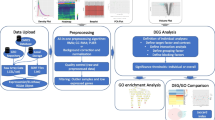Abstract
Purpose
Microarrays have been utilized in many biological, physiological and pharmacological studies as a high-throughput genomic technique. Several generations of Affymetrix GeneChip® microarrays are widely used in gene expression studies. However, differences in intensities of signals for different probe sets that represent the same gene on various types of Affymetrix chips make comparison of datasets complicated.
Materials and Methods
A power coefficient scaling factor was applied in the pharmacokinetic/pharmacodynamic (PK/PD) modeling to account for differences in probe set sensitivities (i.e., signal intensities). Microarray data from muscle and liver following methylprednisolone 50 mg/kg i.v. bolus and 0.3 mg/kg/h infusion regimens were taken as an exemplar.
Results
The scaling factor applied to the pharmacodynamic output function was used to solve the problem of intensity differences between probe sets. This approach yielded consistent pharmacodynamic parameters for the applied models.
Conclusions
Modeling of pharmacodynamic/pharmacogenomic (PD/PG) data from diverse chips should be performed with caution due to differential probe set intensities. In such circumstances, a power scaling factor can be applied in the modeling.





Similar content being viewed by others
Abbreviations
- ADX:
-
adrenalectomized
- BS:
-
biosignal
- CS:
-
corticosteroids
- CV:
-
coefficient of variation
- DR(N):
-
nucleus drug-receptor complex
- GR:
-
glucocorticoid receptor
- GRE:
-
glucocorticoid response element
- MPL:
-
methylprednisolone
- PD:
-
pharmacodynamics
- PG:
-
pharmacogenomics
- PK:
-
pharmacokinetics
References
J. Y. Jin, R. R. Almon, D. C. DuBois, and W. J. Jusko. Modeling of corticosteroid pharmacogenomics in rat liver using gene microarrays. J. Pharmacol. Exp. Ther. 307:93–109 (2003).
Y. N. Sun, D. C. DuBois, R. R. Almon, and W. J. Jusko. Fourth-generation model for corticosteroid pharmacodynamics: a model for methylprednisolone effects on receptor/gene-mediated glucocorticoid receptor down-regulation and tyrosine aminotransferase induction in rat liver. J. Pharmacokinet. Biopharm. 26:289–317 (1998).
Y. N. Sun, L. I. McKay, D. C. DuBois, W. J. Jusko, and R. R. Almon. Pharmacokinetic/Pharmacodynamic models for corticosteroid receptor down-regulation and glutamine synthetase induction in rat skeletal muscle by a Receptor/Gene-mediated mechanism. J. Pharmacol. Exp. Ther. 288:720–728 (1999).
R. Ramakrishnan, D. C. DuBois, R. R. Almon, N. A. Pyszczynski, and W. J. Jusko. Pharmacodynamics and pharmacogenomics of methylprednisolone during 7-day infusions in rats. J. Pharmacol. Exp. Ther. 300:245–256 (2002).
R. R. Almon, J. Chen, G. Snyder, D. C. DuBois, W. J. Jusko, and E. P. Hoffman. In vivo multi-tissue corticosteroid microarray time series available online at Public Expression Profile Resource (PEPR). Pharmacogenomics 4:791–799 (2003).
R. R. Almon, D. C. DuBois, W. H. Piel, and W. J. Jusko. The genomic response of skeletal muscle to methylprednisolone using microarrays: tailoring data mining to the structure of the pharmacogenomic time series. Pharmacogenomics 5:525–552 (2004).
R. R. Almon, D. C. Dubois, J. Y. Jin, and W. J. Jusko. Pharmacogenomic responses of rat liver to methylprednisolone: an approach to mining a rich microarray time series. Aaps J. 7:E156–E194 (2005).
R. R. Almon, W. Lai, D. C. DuBois, and W. J. Jusko. Corticosteroid-regulated genes in rat kidney: mining time series array data. Am. J. Physiol. 289:E870–E882 (2005).
Y. Dong, L. Poellinger, J. A. Gustafsson, and S. Okret. Regulation of glucocorticoid receptor expression: evidence for transcriptional and posttranslational mechanisms. Mol. Endocrinol. 2:1256–1264 (1988).
D. Z. D’Argenio and A. Schumitzky. ADAPT II user’s guide: pharmacokinetic/pharmacodynamic systems analysis software, Biomedical Simulation Resource, Los Angeles, 1997.
Technical note: array design and performance of the genechip rat expression set 230. http://www.affymetrix.com/support/technical/technotesmain.affx.
Acknowledgments
We would like to acknowledge Ms Nancy Pyszczynski for the conduct of animal studies. This work was supported by grants GM24211 and GM67650 from the National Institute of General Medical Sciences, National Institutes of Health, in part by grant R24HD050846 from NICHD National Center for Medical Rehabilitation Research and a research grant from NASA.
Author information
Authors and Affiliations
Corresponding author
Rights and permissions
About this article
Cite this article
Yao, Z., Zhao, B., Hoffman, E.P. et al. Application of Scaling Factors in Simultaneous Modeling of Microarray Data from Diverse Chips. Pharm Res 24, 643–649 (2007). https://doi.org/10.1007/s11095-006-9215-y
Received:
Accepted:
Published:
Issue Date:
DOI: https://doi.org/10.1007/s11095-006-9215-y




